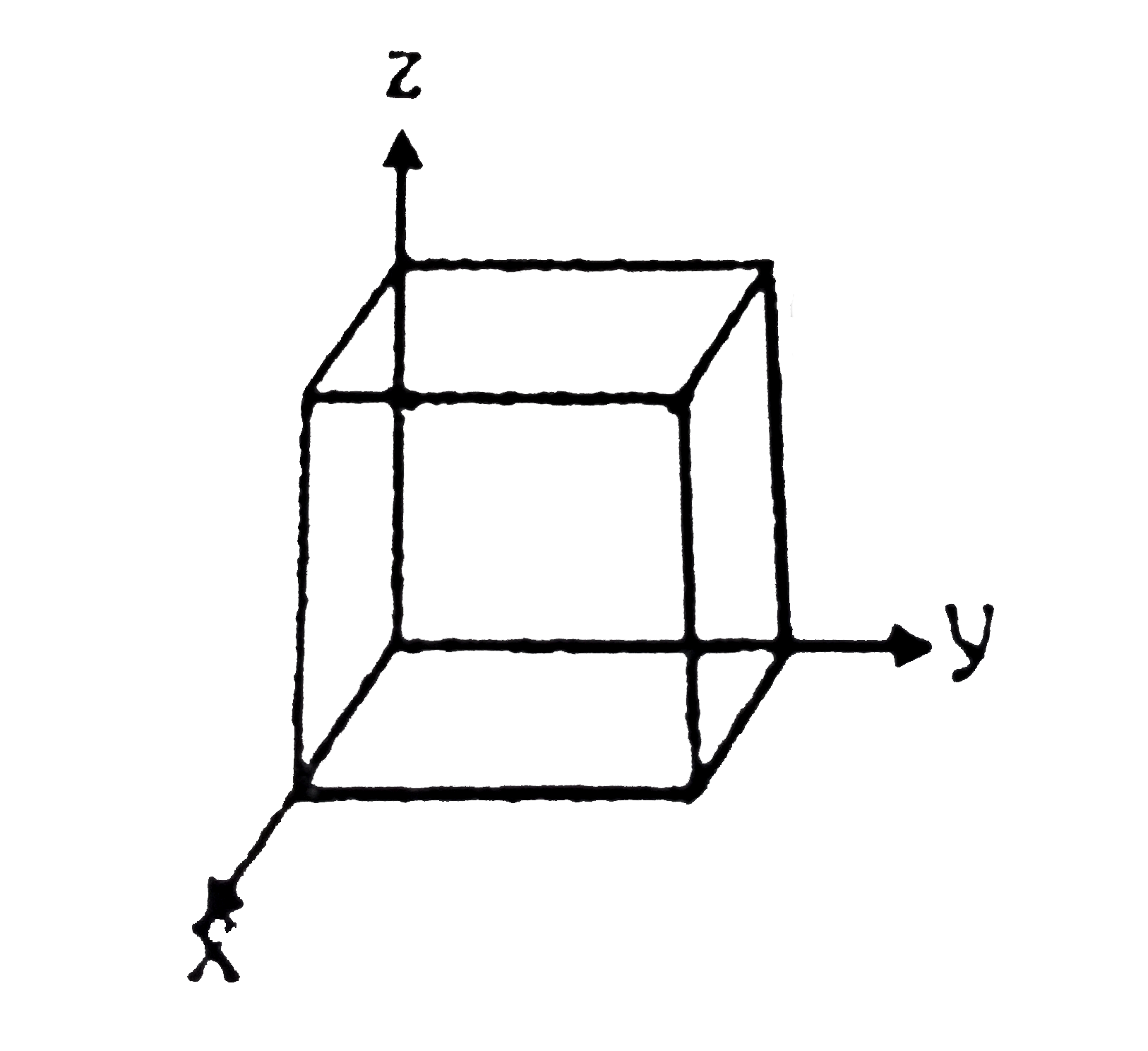The electric field in a region is given by →E=E0xι→i. Find the charge contained inside a cubical volume bounded by the curfaced x=0,x=α,y=0,y=α,z=0andz=α. Take E0=5×103NC−1, ι=2cmandα=1cm.
To find the charge contained inside the cubical volume bounded by the surfaces x=0, x=α, y=0, y=α, z=0, and z=α, we will use Gauss's law, which states:
ΦE=Qinϵ0
where ΦE is the electric flux through a closed surface, Qin is the charge enclosed within that surface, and ϵ0 is the permittivity of free space.
Step 1: Identify the Electric Field
The electric field is given by:
→E=E0xL^i
Given values are:
- E0=5×103N/C
- L=2cm=0.02m
- α=1cm=0.01m
Step 2: Calculate the Electric Field at the Surface x=α
At the surface x=α:
E=E0⋅αL=5×103⋅0.010.02=2.5×103N/C
Step 3: Determine the Area of the Surface
The area of the surface EFGH (where x=α) is:
A=α2=(0.01m)2=1×10−4m2
Step 4: Calculate the Electric Flux through the Surface
The electric flux ΦE through the surface EFGH is given by:
ΦE=E⋅A=(2.5×103)⋅(1×10−4)=0.25N m2/C
Step 5: Apply Gauss's Law
According to Gauss's law:
ΦE=Qinϵ0
Rearranging gives:
Qin=ΦE⋅ϵ0
Step 6: Substitute the Value of ϵ0
Using ϵ0=8.85×10−12C2/N m2:
Qin=0.25⋅(8.85×10−12)=2.21×10−12C
Final Answer
The charge contained inside the cubical volume is:
Qin≈2.21×10−12C
---
The electric field is given by:
- E0=5×103N/C
- L=2cm=0.02m
- α=1cm=0.01m
At the surface x=α:
The area of the surface EFGH (where x=α) is:
The electric flux ΦE through the surface EFGH is given by:
According to Gauss's law:
Using ϵ0=8.85×10−12C2/N m2:
The charge contained inside the cubical volume is:
Topper's Solved these Questions
- BOOK - HC VERMA ENGLISHCHAPTER - GAUSS LAWEXERCISE - Short Question7videos
GAUSS LAW
- BOOK - HC VERMA ENGLISHCHAPTER - GAUSS LAWEXERCISE - Objective 28videos
GAUSS LAW
- BOOK - HC VERMA ENGLISHCHAPTER - ELECTROMAGNETIC WAVESEXERCISE - Exercise8videos
ELECTROMAGNETIC WAVES
- BOOK - HC VERMA ENGLISHCHAPTER - GEOMETRICAL OPTICSEXERCISE - Question For short Answer18videos
GEOMETRICAL OPTICS
Similar Questions
The electric field in a region is given by E=E0xlˆi. Find the charge contained inside a cubical 1 volume bounded by the surfaces x=0,x=a,y=0,yh=,z=0 and z=a. Take E0=5×103N/C l=2cm and a=1m.
View SolutionThe electric field in a region is given by →E=E0xˆi. The charge contained inside a cubical volume bounded by the surface x=0, x=2m, y=0, y=2m, z=0 and z=2m is nε0E0. Find the va,ue of n.
View SolutionThe electric field in a region is given by →E=E0axˆi. Find the electric flux passing through a cubical volume bounded by the surfaces x=0,x=a,y=0,y=a,z=0 and z=a.
View SolutionThe electric field in a region is given by E=αxˆi. Here α is a constant of proper dimensions. Find
a. the total flux passing throug a cube bounded by the surface x=l,x=2l,y=0,y=l,z=0,z=l.
b. the charge contained inside in above cube.View SolutionElectric field in a region is given by →E=−4xˆi+6yˆj. The charge enclosed in the cube of side 1m oriented as shown in the diagram is given by α∈0. Find the value of α.
 View Solution
View SolutionThe electric field in a region is given by →E=35E0→i+45E0→j with E0=2.0×103NC−1. Find the flux of this field through a recatngular surface of area 0.2m2 parallel to the y-z plane.
View SolutionThe electric field in a region is given by E=35E0ˆi+45E0j with E0=2.0×103N/C. Find the flux of this field through a rectangular surface of area 0.2m2 parallel to the y-z plane.
View SolutionIf -1,2 and α are the roots of
2x3+x2−7x−6=0, then find αView SolutionIf α,β and 1 are the roots of x3−2x2−5x+6=0 , then find αandβ
View SolutionThe range of value of α such that (0,α) lies on or inside the triangle formed by the lines y + 3x + 2 = 0, 3y - 2x - 5 = 0, 4y + x - 14 =0 is
View Solution

